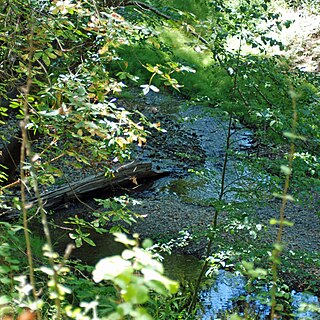Bear Creek (San Francisquito Creek)
| Bear Creek | |
| Arroyo de la Presa Bear Gulch Creek |
|
| stream | |
|
Bear Creek coming down from top of photo to join with Corte Madera Creek at bottom of photo, forming San Francisquito Creek. July 2011.
|
|
| Country | United States |
|---|---|
| State | California |
| Region | San Mateo County |
| Tributaries | |
| - left | West Union Creek, Dry Creek |
| City | Woodside, California |
| Source | Northeast slope of Sierra Morena, California a summit in the Sierra Morena portion of the Santa Cruz Mountains, near Kings Mountain, California |
| - location | Woodside |
| - elevation | 2,150 ft (655 m) |
| - coordinates | 37°25′09″N 122°19′09″W / 37.41917°N 122.31917°W |
| Mouth | San Francisquito Creek |
| - location | Jasper Ridge Biological Preserve, Stanford University |
| - elevation | 256 ft (78 m) |
| - coordinates | 37°24′36″N 122°14′18″W / 37.41000°N 122.23833°WCoordinates: 37°24′36″N 122°14′18″W / 37.41000°N 122.23833°W |
Bear Creek, or Bear Gulch Creek, is a 6.6-mile-long (10.6 km) southeastward-flowing stream originating north of the summit of Sierra Morena in the Santa Cruz Mountains, near the community of Kings Mountain in San Mateo County, California, United States. It flows through the town of Woodside. Bear Creek and Corte Madera Creek join to become San Francisquito Creek in the Jasper Ridge Biological Preserve at Stanford University.
The Spanish called the creek Arroyo de la Presa, meaning "creek of the dam", and it was part of the Rancho Cañada de Raymundo land grant. A foreclosure sale in 1861 records, "Arroyo de la Presa, now called by the Americans Bear Gulch...which heads near the summit of the mountains (Sierra Morena)". The Americans named Bear Creek Gulch for Mexican War veteran James "Grizzly" Ryder's near fatal encounter with the now extinct California grizzly bear (Ursus californicus).
In the Bear Creek sub-basin of the San Francisquito Creek watershed, adult steelhead (Oncorhynchus mykiss) migrate from the Bay to the freshwater streams of Bear, West Union, and Bear Gulch Creeks to spawn. They are listed as a threatened species under the Endangered Species Act. Steelhead smolt spend the first two years of their lives in freshwater, requiring perennial streams, or at least pools, to survive. The anomalously low gradient of the channel of West Union Creek is also related to the fault and creates high quality steelhead habitat, as do the numerous seeps and springs along the fault. The permanent pools created by these seeps and springs are crucial to the survival of steelhead young.
In a 2001 report thirty four barriers to trout migration were identified within Bear Creek and its West Union Creek, Bear Gulch, Squealer Gulch, and McGarvey Gulch tributaries. That report identified the culvert for McGarvey Gulch creek at the Richards Road crossing in Huddart County Park as a significant migration barrier for adult and juvenile steelhead and was reconstructed with funds from the State Department of Transportation’s San Francisco Bay Salmonid Habitat Restoration Fund.
...
Wikipedia

